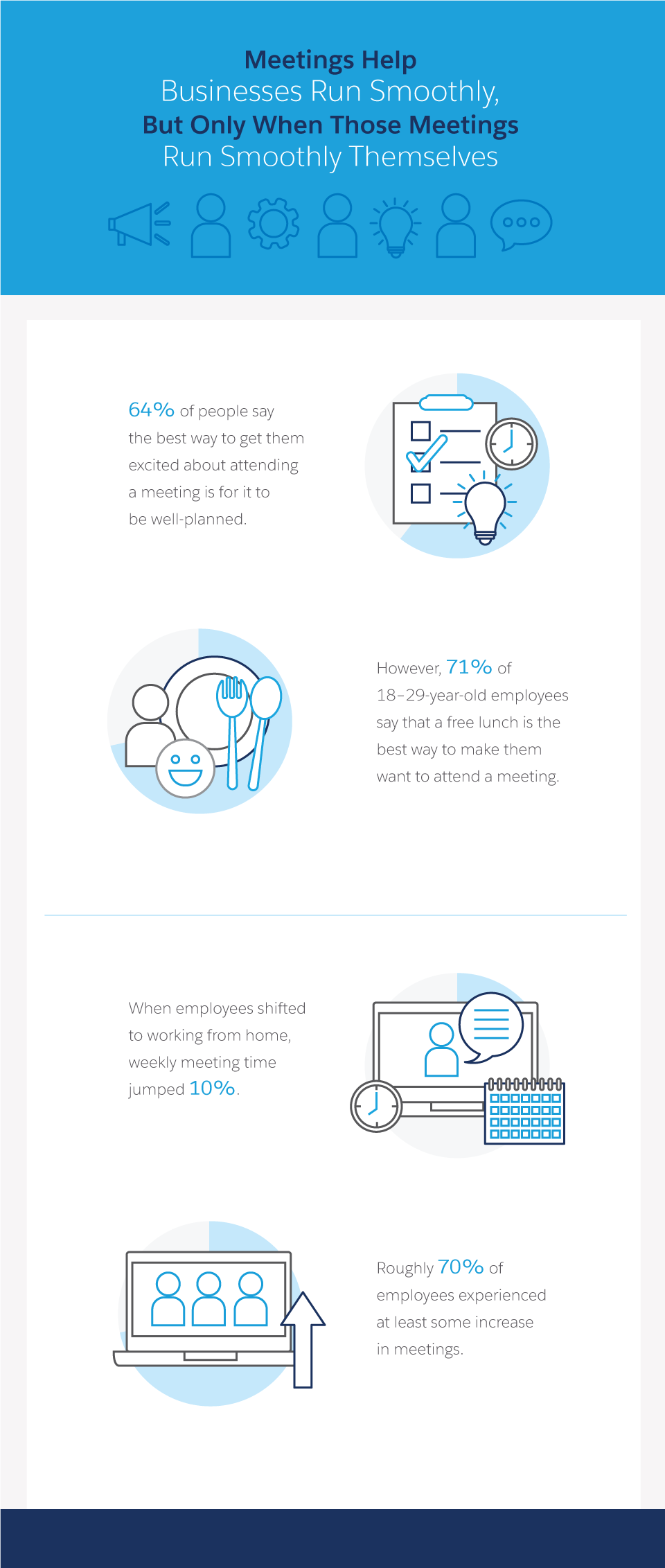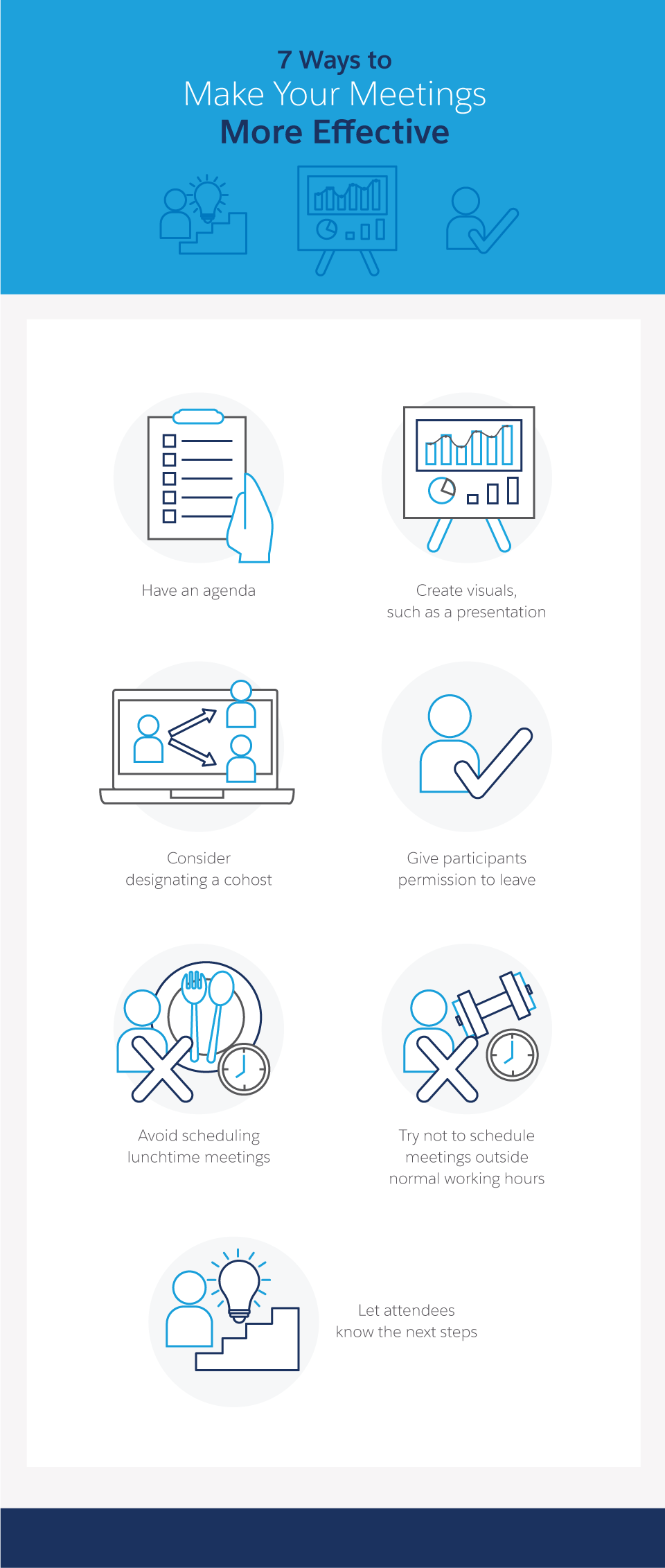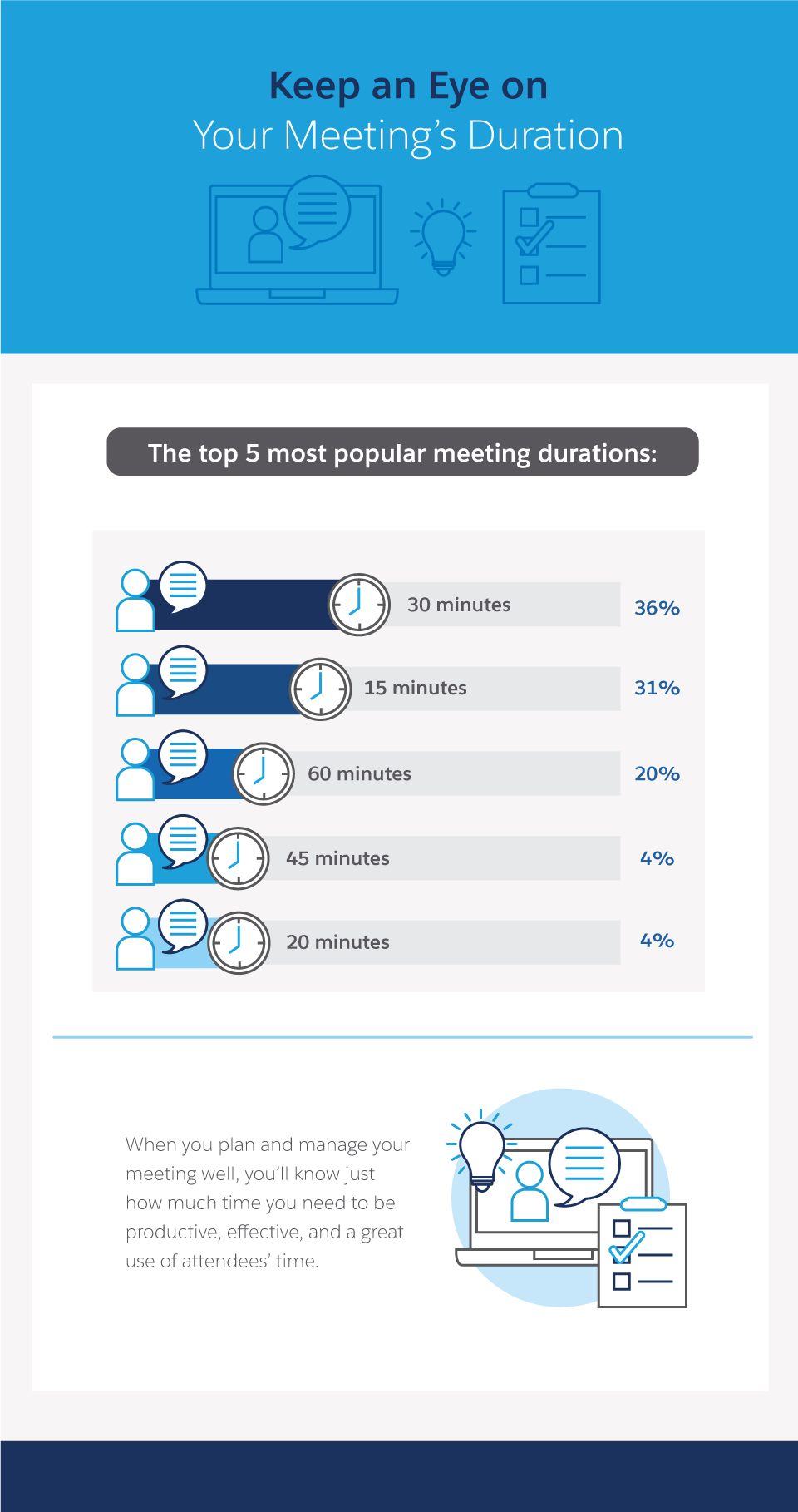7 Ways To Make Meetings As Effective As Possible



Whether you’re hosting your next meeting in the office or remotely, these tips will help you run it more effectively.
Kathleen Garvin
Meetings, for better or for worse, are a part of work life.
They often get a bad rap. Yes, sometimes there can be too many meetings, and some hosts don’t know how to manage their time — or agenda — well.
But like anything in business, you can make changes to your process when it comes to meetings and then examine the results. Depending on your goals, you can measure what is or isn’t working and take action. You could have a few different goals with your meetings.
-
Are you looking to get more team members to show up?
-
Do you want more engagement?
-
Do you want attendees to leave meetings with an action item or feeling?
At its core, your meeting needs to have a purpose and offer value. After all, for many people, especially those with tight schedules, it comes down to a simple question: Is this meeting necessary?
Thankfully, there are actions you can take to make your meetings more efficient for the entire team. Here are seven tips that can help ensure your next meeting runs as effectively as possible. These suggestions will leave your team feeling like the meeting was both productive and helpful.

7 Ways to Improve Your Next Meeting
Hosting a successful meeting goes beyond starting and ending on time (although you should definitely do that). Here are several ways you can improve your next meeting and make it a worthwhile use of everyone’s time.
1. Have an Agenda
Don’t fall victim to hosting “another meeting that could have been an email.” First thing’s first: Determine if you actually need to meet.
Once you pass that test, make an agenda for the call, video chat, or in-person gathering. Creating a meeting agenda up front informs participants what the meeting is about and how they can prepare for certain topics. Include an overview, talking points, a list of who is responsible for which updates, and any calls to action you want attendees to take.
An agenda shows focus and prevents scrambling at the last minute, helping everyone make better use of their time.
2. Make it Visual
You don’t need a 50-slide presentation for a routine meeting. But creating a couple of concise slides can help get your point across and keep attendees engaged with the numbers and bullet-pointed information you want to share.
This is especially helpful in meetings where you have a lot of information to distill, but you need attendees to remember a few key data points to do their jobs. Having this on a slide can help you avoid post-meeting back-and-forth communications and curb misinformation.
3. Consider Bringing in a Cohost
While the business world is now used to the ubiquity of online meetings, there are still hurdles from time to time. Tech glitches, poor Wi-Fi, and virtual-meeting software all require adaptation, and sometimes on the fly.
In these situations, it’s important to control as much as you can. For a large online meeting, consider recruiting a coworker to help you run it.
A cohost can help you moderate when questions arrive in the chat box or people raise their hands, or they can manage who’s promoted to presenter when you hand it off to other speakers. This can free you up to focus on the meeting itself and keep things running smoothly.

4. Give Participants Permission to Leave
Don’t hold attendees hostage. If you have a long meeting on the books and certain portions will only relate to some people, give those participants the option to opt out when the discussion isn’t relevant.
For example, attendees could get the green light to leave a meeting if they are:
-
Providing a status update. Someone in accounts payable might give an update on sales figures, but doesn’t need to stick around for the rest of a business development meeting.
-
Introducing a new policy. Perhaps your company is incorporating a learning budget or giving all employees a home-office stipend. Someone on the people operations team can give details and field questions, and then exit the room.
-
Over-represented. Depending on the type of call, it may make sense for a manager or top-level employee to represent one department, rather than have the entire team present. You ideally want to figure that out ahead of time, but in this case, one person can stay and disseminate essential information to the rest of the team later.
-
In a meeting they don’t need to be in. This has happened to just about everyone, hasn’t it? You’re invited to a meeting and, once in it, you realize it has no bearing on your day-to-day job. In this case, an in-person or virtual open-door policy makes sense for employees who choose to leave.
In large meetings — online especially — it’s easy to leave relatively undetected. Employees don’t need to appear on screen to announce their exit or write in a chat box. Making this clear up front can empower employees to use their time wisely.
5. Avoid Scheduling Meetings Around Lunchtime
You don’t want to interrupt anyone’s break time or distract attendees by making a meeting at noon. Plus, “hangry” workers aren’t the most engaged workers, as you can imagine.
Create strict policies for lunchtime meetings, even company-sponsored ones, to respect workers and their lunch hours. When possible, in order to make up for the loss of that time, have the company pay for lunch. If it’s an online meeting, attendees can turn off their video, go on mute, and eat off camera, sure. But still: companies that are considerate of employees’ lunch breaks generally see higher morale.
Harvard Business Review conducted a global survey in February 2021. Of more than 1,500 respondents in 46 countries across sectors and roles, 89 per cent reported that their work life was getting worse — they were burned out. When people are overworked and exhausted, it has an effect on job performance.
Employers can do their part to help prevent burnout and job creep, which happens when employees work outside regular business hours. Schedule meetings when employees expect to work, not during their breaks or personal time.

6. Steer Clear of Meetings Outside of 9 to 5
For many people, job creep is a major issue, as the lines of work and personal life have been completely blurred. It gets tough for people to operate when there’s no clear distinction between being on and off the clock.
Limit the number of meetings you schedule late in the day and outside of traditional business hours. That means no heavy-duty meetings in the late afternoon on Fridays either, if they can be avoided. Meetings outside your regular business hours can slow down processes and affect deadlines if last-minute “pop-up” meetings become the norm.
Yes, things will come up, and conducting international business may require non-traditional hours. To remedy this, try to be as transparent as possible ahead of time so employees can plan ahead. You can also “give these hours back” to employees by letting them start later or end their working day earlier when they work outside of the normal workday.
The bottom line is to be mindful of infringing on employees’ personal time. Research also shows that happy employees result in better customer experiences and a healthier bottom line. Taking care when scheduling meetings helps your employees avoid burnout and have a better experience working for your company.
7. Determine Next Steps
This ties back to establishing a clear agenda: Once you outline expectations and conduct the meeting, make sure attendees know next steps on a macro and micro level.
Outline action items and how and when people should update the team on each task. If it was an online meeting that was recorded, let employees know how and where to access it in case they need to revisit specific talking points. This also helps cut down on time-zapping back-and-forth communication.
Facilitate Better Meetings
Whether you’re hosting your next meeting in the office or remotely, these tips will help you run it more effectively. When your team recognizes that your meetings are a good, productive use of time, they may even start looking forward to them.
Okay, maybe it’s a little difficult to be excited about meetings. But at least employees won’t look for an excuse to bail and will come away from meetings feeling productive and more prepared for their own work. That’s a win.





















